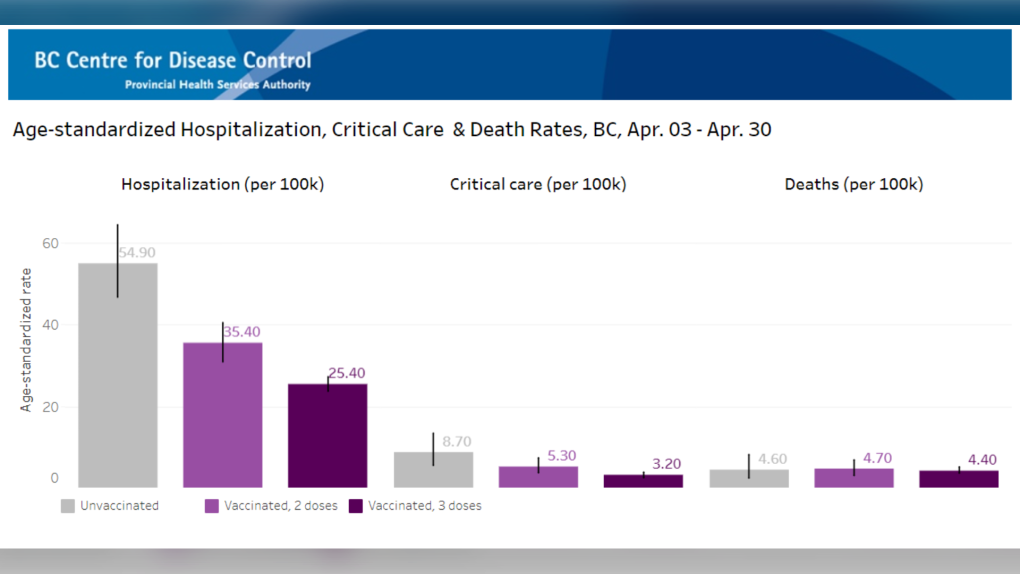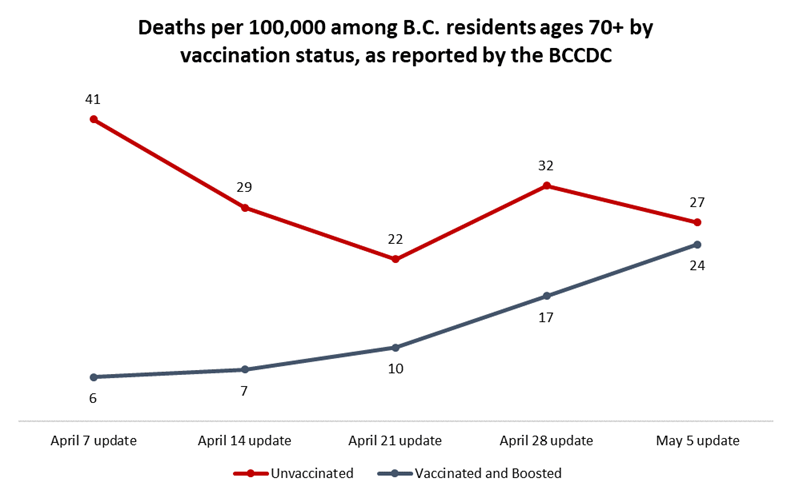B.C.'s new method of counting COVID-19 deaths may be obscuring benefit of vaccination
 A screenshot from the B.C. Centre for Disease Control's COVID-19 Surveillance Dashboard shows little difference in death rates by vaccination status between April 3 and 30. (BCCDC)
A screenshot from the B.C. Centre for Disease Control's COVID-19 Surveillance Dashboard shows little difference in death rates by vaccination status between April 3 and 30. (BCCDC)
While it's long been known that vaccination significantly reduces the likelihood of severe outcomes from COVID-19, B.C.'s recent change to how it reports deaths related to the disease may be making it harder to see that in the data.
On April 2, the province began reporting "30-day, all-cause mortality" in its weekly COVID-19 updates. This means anyone in the province who dies within 30 days of a positive lab test for the coronavirus is reported as a COVID-19 death, regardless of whether the disease actually caused the fatality.
This change appears to be at least partially responsible for recent shifts in the death rates reported on the B.C. Centre for Disease Control's COVID-19 Surveillance Dashboard, which now shows essentially no difference in age-adjusted deaths per 100,000 people across different vaccination statuses.
The Ministry of Health says the data on the dashboard shouldn't be interpreted as an indication of decreased vaccine efficacy.
WHAT THE DATA SAYS
The BCCDC dashboard shows that between April 3 and 30, there were 204 deaths involving people who had tested positive for COVID-19 over the preceding 30 days in B.C.
Of those, 155 - 76 per cent of the total - were people who had received three doses of a COVID-19 vaccine. Another 30 (15 per cent) were people who had received two doses, four (two per cent) were people who had received one dose, and 15 (seven per cent) were people who were unvaccinated.
These raw totals don't account for the significant differences between the populations, however, such as the fact that the triple-vaccinated group is significantly larger and older, on average, than the other groups.
To adjust for these differences, the BCCDC calculates and reports "age-standardized" death rates per 100,000 people for the three largest groups: the unvaccinated, the double-vaccinated and the triple-vaccinated.
For the period in question, after adjusting for age, there were 4.6 deaths per 100,000 unvaccinated people, 4.7 deaths per 100,000 double-vaccinated people and 4.4 deaths per 100,000 triple-vaccinated people.
Compare that to just a few months ago, before the switch to all-cause mortality. Between Jan. 29 and Feb. 25, the age-adjusted death rate among the unvaccinated was 17.7 deaths per 100,000 people, compared to 7.6 per 100,000 among those with two shots and 2.9 per 100,000 among those with three.
The April 3 to 30 data is the first time since the dashboard was launched nearly a year ago that the difference between age-standardized death rates across the different groups has been so small.
It's also the first time that the period covered on the dashboard has included only deaths recorded under the all-cause mortality method.
HOW THE DATA IS LIMITED
The BCCDC maintains that comparisons between deaths reported before the April 2 switch and after it are unreliable.
Despite this, the dashboard – which reports roughly one month's worth of data at a time – continued to report deaths and death rates using a mix of the two systems during the month of April, when the data presented stretched back to dates before April 2.
During that time, CTV News was tracking and calculating death rates among triple-vaccinated and unvaccinated people in the vulnerable 70-plus age group. The analysis found that, as the total number of deaths came to include more weeks in which all-cause mortality was being reported, the difference between the two death rates narrowed significantly.
 As successive updates from the B.C. Centre for Disease Control included more deaths reported after the April 2 switch to all-cause mortality reporting, the death rate among triple-vaccinated B.C. residents ages 70 and older climbed. (CTV)
As successive updates from the B.C. Centre for Disease Control included more deaths reported after the April 2 switch to all-cause mortality reporting, the death rate among triple-vaccinated B.C. residents ages 70 and older climbed. (CTV)
CTV News asked the Ministry of Health how the switch to all-cause mortality could contribute to the flattening of death rates across vaccination groups – both age-adjusted and among those ages 70 and older – given the apparent correlation in the data.
"Ultimately, there are two important things to consider," the ministry said in its response.
"The first is that the overall number of deaths in people age 70 and older are relatively small. While your graphs are correct, when the overall numbers are small, the rates are unstable and are more likely to fluctuate over time."
"The second is that we switched to a new reporting system in early April which makes comparisons between the death data from before April with current data unreliable. In the new system, deaths include any COVID-19 lab positive cases who died from any cause recorded within 30 days of their first positive lab result date. This means the numbers are dependent on testing rates in people aged 70 and older. Testing rates are typically higher for those with three doses of vaccine and there may be other differences across 70-year-olds who have different vaccination status that are not accounted for in the numbers."
VACCINE EFFECTIVENESS
The ministry added that the numbers reported on the dashboard - though they include calculations of outcomes by vaccination status - are not measures of vaccine effectiveness.
"They simply show surveillance data and do not adjust for differences by testing, prior infection, and other important factors that may differ among populations with different vaccination status," the ministry said.
Calculations of vaccine effectiveness in B.C. take these factors into account, and the ministry said updated calculations are on the way.
"Vaccine effectiveness results by age and time since last dose are being finalized and will be shared publicly soon," the ministry said.
"For vaccine effectiveness analyses, we would be limiting analyses to deaths primarily from COVID (rather than all-cause mortality)," it added.
The most recent study of vaccine effectiveness in B.C. looked at the period from September 2021 to February 2022, when Delta and Omicron were the dominant variants in the province.
The summary of that study on the BCCDC website does not mention deaths, but it does conclude that vaccines "provided good protection against severe outcomes," with two doses estimated to prevent 65 to 75 per cent of hospitalizations from Omicron and a booster dose increasing that protection to more than 90 per cent.
CTVNews.ca Top Stories

Donald Trump says he urged Wayne Gretzky to run for prime minister in Christmas visit
U.S. president-elect Donald Trump says he told Canadian hockey legend Wayne Gretzky he should run for prime minister during a Christmas visit but adds that the athlete declined interest in politics.
Ho! Ho! HOLY that's cold! Montreal boogie boarder in Santa suit hits St. Lawrence waters
Montreal body surfer Carlos Hebert-Plante boogie boards all year round, and donned a Santa Claus suit to hit the water on Christmas Day in -14 degree Celsius weather.
Historical mysteries solved by science in 2024
This year, scientists were able to pull back the curtain on mysteries surrounding figures across history, both known and unknown, to reveal more about their unique stories.
Montreal man dead after boat explodes in Fort Lauderdale
A Montreal man is dead and several others are injured after a boat exploded in Fort Lauderdale, Florida.
Mother-daughter duo pursuing university dreams at the same time
For one University of Windsor student, what is typically a chance to gain independence from her parents has become a chance to spend more time with her biggest cheerleader — her mom.
Azerbaijani airliner crashes in Kazakhstan, killing 38 with 29 survivors, officials say
An Azerbaijani airliner with 67 people onboard crashed Wednesday near the Kazakhstani city of Aktau, killing 38 people and leaving 29 survivors, a Kazakh official said.
King Charles III focuses Christmas message on healthcare workers in year marked by royal illnesses
King Charles III used his annual Christmas message Wednesday to hail the selflessness of those who have cared for him and the Princess of Wales this year, after both were diagnosed with cancer.
Alberta premier hopes for health reform payoff in 2025, regrets deferring tax cut
"It may have been better for Albertans if we'd implemented and then found a way to be able to pay for it."
NFL's Netflix debut on Christmas Day kicked off without a glitch
Mariah Carey opened Wednesday’s doubleheader with a taped performance of “All I Want for Christmas is You” before Patrick Mahomes, Travis Kelce and the two-time defending Super Bowl champion Kansas City Chiefs faced off against Russell Wilson, T.J. Watt and the Pittsburgh Steelers.
































